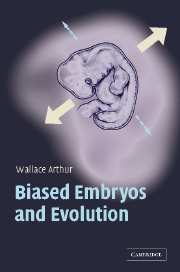Book contents
- Frontmatter
- Contents
- Preface
- Acknowledgements
- 1 The microscopic horse
- 2 What steers evolution?
- 3 Darwin: pluralism with a single core
- 4 How to build a body
- 5 A brief history of the last billion years
- 6 Preamble to the quiet revolution
- 7 The return of the organism
- 8 Possible creatures
- 9 The beginnings of bias
- 10 A deceptively simple question
- 11 Development's twin arrows
- 12 Action and reaction
- 13 Evolvability: organisms in bits
- 14 Back to the trees
- 15 Stripes and spots
- 16 Towards ‘the inclusive synthesis’
- 17 Social creatures
- Glossary
- References
- Index
16 - Towards ‘the inclusive synthesis’
Published online by Cambridge University Press: 02 December 2009
- Frontmatter
- Contents
- Preface
- Acknowledgements
- 1 The microscopic horse
- 2 What steers evolution?
- 3 Darwin: pluralism with a single core
- 4 How to build a body
- 5 A brief history of the last billion years
- 6 Preamble to the quiet revolution
- 7 The return of the organism
- 8 Possible creatures
- 9 The beginnings of bias
- 10 A deceptively simple question
- 11 Development's twin arrows
- 12 Action and reaction
- 13 Evolvability: organisms in bits
- 14 Back to the trees
- 15 Stripes and spots
- 16 Towards ‘the inclusive synthesis’
- 17 Social creatures
- Glossary
- References
- Index
Summary
I like to think of this book as a contribution to a growing movement whose goal is to transform the ‘modern’ synthesis of the twentieth century into a more inclusive synthesis that is appropriate for the twenty-first. And, having looked at the various pieces of the puzzle over the last several chapters, we are now in a position to try to put them together. I don't want to overstate what can be achieved at the present time, when so much research in evo-devo still remains to be done. That's why I put ‘towards’ in the chapter title. But I don't want to understate the case either. We can already build a significantly more inclusive synthesis, even if further inclusivity is yet to follow.
There are two possible ways in which the old synthesis might be affected as it evolves into the new, or, perhaps more accurately, a spectrum of possibilities between two extremes. At one end of this spectrum lies the possibility that the old is unaffected by the new, in the same way that a building may be largely unaffected by an extension built on to one of its sides. At the other end lies the possibility that the old is effectively demolished by the new, as when a crumbling old building is bulldozed to make way for a new one (Figure 30).
My current view is that the relationship between the ‘modern synthesis’ and the ‘inclusive synthesis’ is somewhere in between these two extremes.
- Type
- Chapter
- Information
- Biased Embryos and Evolution , pp. 190 - 199Publisher: Cambridge University PressPrint publication year: 2004



